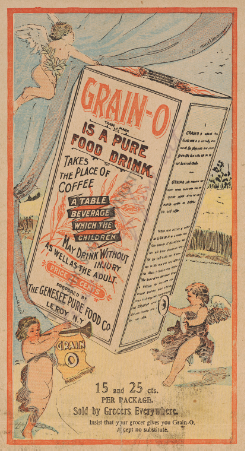My mother became concerned when I was young that my fingernails were too thin and brittle. I don’t recall them being particularly weak, but I was only 8 or 9 so for all I know they were shockingly abnormal and something had to be done about them. So for a brief period I was made to eat a great deal of Jell-O. I hate Jell-O. I hated it when I was a child, and I hate it now. It’s not so much able the flavors as it is about the texture. The unnatural feeling of Jell-O in my mouth still provokes my throat to clamp shut and results in dramatic and embarrassing convulsions. I have nothing against the Jell-O corporation, however. Many people enjoy their fine and low fat product. But as I write I can feel the raspberry Jell-O sliding around on my tongue, and I’m already woozy.
Previously, I mentioned that Peter Cooper invented Jell-O. That is only mostly true. As with most inventions, there was no single moment when the elements all came together and began to jiggle. Jell-O took a journey.
The Jell-O museum describes the history of the substance-- http://www.jellomuseum.com/index.html
Really, the desert Jell-O was created based on Cooper’s original gelatin setting process (having purchased the patent) by Pearle and May Wait. Pearle was a man. The Waits tried to market the product, but lacked the capital to do so, so the patent, along with the name Jell-O, were purchased again by the fantastically names Orator F. Woodward.
Orator F. Woodward produced not only Jell-O, but also Grain-O, a “roasted cereal coffee ‘for those who can’t drink tea and coffee.’” Grain-O sales apparently paid for the development and promotion of Jell-O. This product intrigued me, mostly because Grain-O conjures up images of both plumbing products and an overabundance of fiber in the diet. To the library!

I found the following advertisement for Grain-O in “A Collection of Delectable Recipes, Tried and True” published by the Unitarian Church out of Waterville, ME in 1898.
I have reproduced the format to the best of my ability.
GRAIN-O
…is a…
PURE FOOD DRINK
It takes the place of coffee. It is a table
beverage which the children may drink
without injury, as well as the adult. Grain-O
looks and tastes like coffee, but it made
from pure grains, and the most delicate
stomach receives it without stress.
It’s Nourishing and Strengthening.
A lady said: “The first cup I used I did not
like it, but after using it a week nothing
could induce me to go back to coffee.”
Try GRAIN-O Try GRAIN-O
_________
Prepared by the
Genesee Pure Food Company
Le Roy, New York
15c and 25c per package Sold by all grocers.
Ah, Grain-O. Try it and you won’t like it, but eventually you’ll get used to the taste and become addicted to it! Try it! TRY IT!
Grain-O was apparently extremely popular for a time, as apparently sentiment against coffee was high, and people wanted their children to be able to drink bitter things.
From the New York Times, on May 24, 1897, “the great $50,000 damage suit instituted by a Michigan Cereal Company against the Genesee Pure Food company is at an end. They settled it and took it out of court for the ridiculously small sum of $500, and, as a practical result, Grain-O is in greater demand than ever. The new plant, only just completed, is to be duplicated, so that not only the old friends of the delicious food drink, which completely takes the place of coffee, but the new friends it is making every day, can be supplied. The beverage which the children, as well as the adult, may drink with benefit, will be furnished in unlimited quantities. Suits may come and suits may go, but Grain-O goes on forever—N.Y. Mail and Express.”
The above is not an advertisement, but a news release, ever so slightly biased.
Grain-O was one of many cereal based coffee substitues on the market at the time. The Publications of the Maine Agriculture Experiement Station published in 1901 lists several which it subjected to analyses of solubility and nutritional content (pages 103-105).
Previously, I mentioned that Peter Cooper invented Jell-O. That is only mostly true. As with most inventions, there was no single moment when the elements all came together and began to jiggle. Jell-O took a journey.
The Jell-O museum describes the history of the substance-- http://www.jellomuseum.com/index.html
Really, the desert Jell-O was created based on Cooper’s original gelatin setting process (having purchased the patent) by Pearle and May Wait. Pearle was a man. The Waits tried to market the product, but lacked the capital to do so, so the patent, along with the name Jell-O, were purchased again by the fantastically names Orator F. Woodward.
Orator F. Woodward produced not only Jell-O, but also Grain-O, a “roasted cereal coffee ‘for those who can’t drink tea and coffee.’” Grain-O sales apparently paid for the development and promotion of Jell-O. This product intrigued me, mostly because Grain-O conjures up images of both plumbing products and an overabundance of fiber in the diet. To the library!

I found the following advertisement for Grain-O in “A Collection of Delectable Recipes, Tried and True” published by the Unitarian Church out of Waterville, ME in 1898.
I have reproduced the format to the best of my ability.
GRAIN-O
…is a…
PURE FOOD DRINK
It takes the place of coffee. It is a table
beverage which the children may drink
without injury, as well as the adult. Grain-O
looks and tastes like coffee, but it made
from pure grains, and the most delicate
stomach receives it without stress.
It’s Nourishing and Strengthening.
A lady said: “The first cup I used I did not
like it, but after using it a week nothing
could induce me to go back to coffee.”
Try GRAIN-O Try GRAIN-O
_________
Prepared by the
Genesee Pure Food Company
Le Roy, New York
15c and 25c per package Sold by all grocers.
Ah, Grain-O. Try it and you won’t like it, but eventually you’ll get used to the taste and become addicted to it! Try it! TRY IT!
Grain-O was apparently extremely popular for a time, as apparently sentiment against coffee was high, and people wanted their children to be able to drink bitter things.
From the New York Times, on May 24, 1897, “the great $50,000 damage suit instituted by a Michigan Cereal Company against the Genesee Pure Food company is at an end. They settled it and took it out of court for the ridiculously small sum of $500, and, as a practical result, Grain-O is in greater demand than ever. The new plant, only just completed, is to be duplicated, so that not only the old friends of the delicious food drink, which completely takes the place of coffee, but the new friends it is making every day, can be supplied. The beverage which the children, as well as the adult, may drink with benefit, will be furnished in unlimited quantities. Suits may come and suits may go, but Grain-O goes on forever—N.Y. Mail and Express.”
The above is not an advertisement, but a news release, ever so slightly biased.
Grain-O was one of many cereal based coffee substitues on the market at the time. The Publications of the Maine Agriculture Experiement Station published in 1901 lists several which it subjected to analyses of solubility and nutritional content (pages 103-105).
Postum Cereal (Postum Cereal Company, Battle Creek Michigan)
Caramel Cereal (Battle Creek Sanitarium Health Food Company, Battle Creek, Michigan)
Golden Grain Coffee (John A Tibbs, Buffalo, NY...not actually coffee)
Old Grist Mill Entire Wheat Coffee (Potter and Wrightington, Boston, Mass...not actually coffee)
Grain-O (Genesee Pure Food Company, Le Roy, NY)
Dr. Johnson's Cereal Coffee (Johnson Food Educator Food Store, Boston, Mass...not coffee)
Mo-Ko (John F. Bauer and Company, Mt. Morris NY)
Don't these all just sound scrumptious!
Postum Cereal drink was actually sold until 2007, sometimes with the aid of Mr. Coffee Nerves!
Next stop...the Woodward family and the cereal wars.
